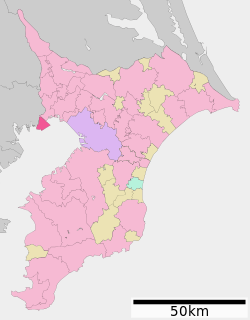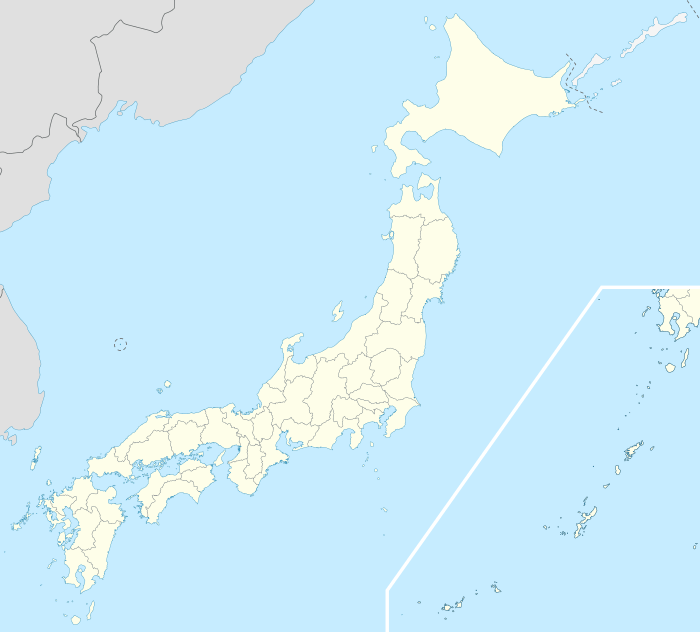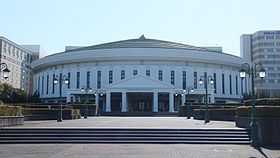Urayasu
| Urayasu 浦安市 | |||
|---|---|---|---|
| City | |||
|
Urayasu City Hall | |||
| |||
 Location of Urayasu in Chiba Prefecture | |||
 Urayasu
| |||
| Coordinates: 35°39′N 139°54′E / 35.650°N 139.900°ECoordinates: 35°39′N 139°54′E / 35.650°N 139.900°E | |||
| Country | Japan | ||
| Region | Kantō | ||
| Prefecture | Chiba Prefecture | ||
| Government | |||
| • - Mayor | Hideki Matsuzaki (since November 1998) | ||
| Area | |||
| • Total | 17.29 km2 (6.68 sq mi) | ||
| Population (April 2012) | |||
| • Total | 163,013 | ||
| • Density | 9,430/km2 (24,400/sq mi) | ||
| Time zone | Japan Standard Time (UTC+9) | ||
| -Tree | Ginkgo biloba | ||
| - Flower | Azalea | ||
| Phone number | 047-351-1111 | ||
| Address | 1-1-1 Nekozane, Urayasu-shi, Chiba-ken 279-8501 | ||
| Website | Urayasu City | ||
Urayasu (浦安市 Urayasu-shi) is a city located in the far western corner of northern Chiba Prefecture, Japan.
As of April 2012, the city has an estimated population of 163,013 and a population density of 9430 persons per km². The total area is 17.29 km².
Urayasu is best known as the home of the Tokyo Disney Resort, which opened in 1983,[1] and the headquarters of The Oriental Land Company.[2]
Geography
Urayasu is located in the delta of the Edo River. The river runs along the western side of the city and separates it from the Edogawa ward of Tokyo.[3] There are two parts to Urayasu: the original fishing village on Tokyo Bay, and the newer reclaimed land portion that adjoins Tokyo Disneyland. The new landfill area is called "Shin-Urayasu" (New-Urayasu), and has an "American" inspired layout, with a grid-like map of wide streets, large sidewalks, palm trees and parks. The buildings are tall, modern apartments, some having views on Tokyo Bay. Urayasu is one of the most sought after areas in the metropolitan area for young families to live. However, plans are already under way to turn the local school facilities into retirement facilities in the future.
2011 Tōhoku earthquake and tsunami
Urayasu was greatly affected by the March 2011 Tōhoku earthquake and tsunami. The reclaimed land across most of northern Chiba Prefecture was damaged by soil liquefaction in the earthquake. Urayasu, with major areas of reclaimed land, had as much as 85% of the utility infrastructure, roads, buildings, and houses damaged or affected to some degree by soil liquefaction. The damage cost the city approximately ¥73.4 billion to repair.[4][5]
Neighboring municipalities
History
Early history
The area around Urayasu was tenryo territory within Shimōsa Province controlled directly by the Tokugawa shogunate during the Edo period. Urayasu served as an important fishing village for the Edo capitol.[1] Until the industrialization of the city it was a major center of production of nori, an edible seaweed, hamaguri, the common orient clam, and asari, the Japanese cockle.[3] All three are important elements of the traditional Japanese diet.
Modern history
After the Meiji Restoration in 1868 it became part of Chiba Prefecture. Urayasu Village was created on April 1, 1889 under Higashikatsushika District. Urayasu became a town in September 1909. Many of the residents of Urayasu perished during the 1944 Bombing of Tokyo. Urayasu grew in the 1960s and 1970s with massive landfill projects along the shores of Tokyo Bay, public housing projects, and increasing infrastructure. Urayasu became part of the Keiyō Industrial Zone in this period, which spans from the city across the Tokyo Bay coast of Chiba Prefecture to Futtsu to the south. Fishing was abandoned in Urayasu in 1971 due to the industrialization of the city.[3] Urayasu was elevated to city status on April 1, 1981.
Economy

Urayasu is a regional commercial center and a bedroom community for nearby Chiba and Tokyo. The primary employer in the city is The Oriental Land Company and businesses related to Tokyo Disney Resort.
Education
Universities
Transportation
Railway
- East Japan Railway Company (JR East) - Keiyō Line
- Tokyo Metro - Tokyo Metro Tōzai Line
- Maihama Resort Line - Disney Resort Line
- Resort Gateway - Tokyo Disneyland - Bayside - Tokyo DisneySea - Resort Gateway
Highway
Sister City relations
-
 – Orlando, Florida, United States, since October 23, 1989
– Orlando, Florida, United States, since October 23, 1989
Noted people from Urayasu
- Keita Amemiya – Video game designer
- Shinnosuke Abe – professional baseball player
- Keiji Tamada – professional soccer player
- Daisuke Hayakawa – professional baseball player
References
- ↑ 1.0 1.1 "Urayasu". Encyclopedia of Japan. Tokyo: Shogakukan. 2012. Retrieved 2012-05-16.
- ↑ "Summary." OLC Group. Retrieved on October 1, 2009.
- ↑ 3.0 3.1 3.2 "Urayasu". Nihon Daihyakka Zensho (Nipponika) (in Japanese). Tokyo: Shogakukan. 2012. Retrieved 2012-05-16.
- ↑ Fukue, Natsuko, "Urayasu still dealing with liquefaction", Japan Times, 8 April 2011, p. 4.
- ↑ Yomiuri Shimbun, "Liquefaction Damage Widespread", 10 April 2011.
External links
| Wikimedia Commons has media related to Urayasu. |
- Urayasu official website (Japanese)
- Urayasu tourist association (Japanese)
- Urayasu city museum (Japanese)
| ||||||||||||||||||||||||||||||||||||

